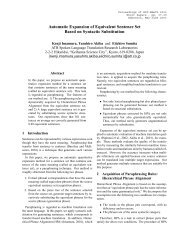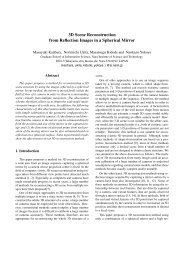Unknown Word Guessing and Part-of-Speech Tagging ... - CiteSeerX
Unknown Word Guessing and Part-of-Speech Tagging ... - CiteSeerX
Unknown Word Guessing and Part-of-Speech Tagging ... - CiteSeerX
You also want an ePaper? Increase the reach of your titles
YUMPU automatically turns print PDFs into web optimized ePapers that Google loves.
<strong>Unknown</strong> <strong>Word</strong> <strong>Guessing</strong> <strong>and</strong> <strong>Part</strong>-<strong>of</strong>-<strong>Speech</strong> <strong>Tagging</strong> UsingSupport Vector MachinesTetsuji Nakagawa, Taku Kudoh <strong>and</strong> Yuji MatsumotoGraduate School <strong>of</strong> Information Science,Nara Institute <strong>of</strong> Science <strong>and</strong> Technology8916−5 Takayama, Ikoma, Nara 630−0101, Japan{tetsu-na,taku-ku,matsu}@is.aist-nara.ac.jpAbstractThe accuracy <strong>of</strong> part-<strong>of</strong>-speech(POS) tagging for unknown wordsis substantially lower than that forknown words. Considering the highaccuracy rate <strong>of</strong> up-to-date statisticalPOS taggers, unknown wordsaccount for a non-negligible portion<strong>of</strong> the errors. This paper describesPOS prediction for unknown wordsusing Support Vector Machines.We achieve high accuracy in POStag prediction using substrings <strong>and</strong>surrounding context as the features.Furthermore, we integrate thismethod with a practical EnglishPOS tagger, <strong>and</strong> achieve accuracy<strong>of</strong> 97.1%, higher than conventionalapproaches.1 Introduction<strong>Part</strong>-<strong>of</strong>-speech (POS) tagging is fundamentalin natural language processing. Manystatistical POS taggers use text data whichare manually annotated with POS tags astraining data to obtain the statistical informationor rules to perform POS tagging.However, in part-<strong>of</strong>-speech tagging, we frequentlyencounter words that do not existin training data. Such unknown words areusually h<strong>and</strong>led by an exceptional processing,because the statistical information orrules for those words are unknown. Manymachine learning methods have been appliedfor part-<strong>of</strong>-speech tagging, such as thehidden Markov model (HMM) (Charniak etal., 1993), the transformation-based errordrivensystem (Brill, 1995), the decision tree(Schmid, 1994) <strong>and</strong> the maximum entropymodel (Ratnaparkhi, 1996). Though thesemethods have good performance, the accuracyfor unknown words is much lower thanthat for known words, <strong>and</strong> this is a nonnegligibleproblem where training data is limited(Brants, 2000).One known approach for unknown wordguessing is to use suffixes or surroundingcontext <strong>of</strong> unknown words (Thede, 1998).Weischedel estimated conditional probabilityfor an unknown word w given a tag t usingthe ending form <strong>of</strong> w, the existence <strong>of</strong> hyphenation<strong>and</strong> capitalization (Weischedel etal., 1993):p(w|t) = p(unknown word|t) · p(capital|t)·p(ending/hyphenation|t)Although this method has the merit in h<strong>and</strong>lingunknown words within the framework<strong>of</strong> probability theory, ending forms like “-ed” <strong>and</strong> “-ion” are selected heuristically, soapplying this method to other languages isnot straightforward. Brants used the linearinterpolation <strong>of</strong> fixed length suffix modelfor unknown word h<strong>and</strong>ling in his part-<strong>of</strong>speechtagger TnT (Brants, 2000). Thismethod achieves relatively high accuracy <strong>and</strong>is reported to be effective for other languages(Džeroski et al., 2000). Cucerzan <strong>and</strong>Yarowsky proposed paradigmatic similaritymeasures <strong>and</strong> showed a good result for highlyinflectional languages using a large amount <strong>of</strong>unannotated text (Cucerzan <strong>and</strong> Yarowsky,2000). Other methods for unknown wordguessing have been studied, such as the
ule-based method (Mikheev, 1997) <strong>and</strong> thedecision tree-based method (Orphanos <strong>and</strong>Christodoulakis, 1999).In this paper, we propose a method to predictPOS tags <strong>of</strong> unknown English words asa post-processing <strong>of</strong> POS tagging using SupportVector Machines (SVMs). SVMs (Cortes<strong>and</strong> Vapnik, 1995; Vapnik, 1999) are a supervisedmachine learning algorithm for binaryclassification <strong>and</strong> known to have good generalizationperformance. SVMs can h<strong>and</strong>lea large number <strong>of</strong> features <strong>and</strong> hardly overfit.Consequently, SVMs can be applied successfullyto natural language processing applications(Joachims, 1998; Kudoh <strong>and</strong> Matsumoto,2000). In this paper, we show howto apply SVMs to more general POS taggingas well as unknown word guessing, <strong>and</strong> reportsome experimental results.The paper is organized as follows: We startby presenting Support Vector Machines in thenext section. We then describe our methodfor unknown word guessing <strong>and</strong> POS taggingin sections 3 <strong>and</strong> 4. In section 5, we describethe results <strong>of</strong> some experiments.2 Support Vector MachinesSupport Vector Machines (SVMs) are supervisedmachine learning algorithm for binaryclassification on a feature vector space x ∈R L .w · x + b = 0, w ∈ R L , b ∈ R. (1)Suppose the hyperplane (1) separates thetraining data, {(x i , y i ) | x i ∈ R L , y i ∈ {±1},1 ≤ i ≤ l}, into two classes such thaty i · (w · x i + b) ≥ 1. (2)While several <strong>of</strong> such separating hyperplanesexist (Figure 1, left), SVMs find the optimalhyperplane that maximizes the margin(the distance between the hyperplane <strong>and</strong> thenearest points) (Figure 1, right). Such ahyperplane is known to have the minimumexpected test error <strong>and</strong> can be solved byquadratic programming. Given a test examplex, its label y is decided by the sign <strong>of</strong>Positive ExampleNegative ExampleFigure 1: Maximize the Margindiscriminant function f(x) as follows:Marginf(x) = w · x + b, (3)y = sgn(f(x)). (4)For linearly non-separable cases, featurevectors are mapped into a higher dimensionalspace by a nonlinear function Φ(x) <strong>and</strong> linearlyseparated there. In SVMs’ formula,since all data points appear as a form <strong>of</strong> innerproduct, we only need the inner product<strong>of</strong> two points in the higher dimensional space.Those values are calculated in R L withoutmapping to the higher dimensional space bythe following function K(x i , x j ) called a kernelfunction,Φ(x i ) · Φ(x j ) = K(x i , x j ). (5)In this paper, we use the following polynomialkernel function,K(x i , x j ) = (x i · x j + 1) d . (6)This function virtually maps the original inputspace into a higher dimensional spacewhere all combinations <strong>of</strong> up to d features aretaken into consideration.Since SVMs are binary classifiers, we mustextend them to multi-class classifiers to predictk > 2 POS tags. Among several methods<strong>of</strong> multi-class classification for SVMs (Weston<strong>and</strong> Watkins, 1999), we employ the oneversus-restapproach. In training, k classifiersf i (x) (1 ≤ i ≤ k) are created to classify theclass i from all other classes,{ fi (x) ≥ +1 x belongs to the class i,(7)f i (x) ≤ −1 otherwise.
Table 1: Example <strong>of</strong> Features for <strong>Unknown</strong><strong>Word</strong> <strong>Guessing</strong>POSContext<strong>Word</strong>ContextSubstringst −1 =TO, t −2 =VBD,t +1 =CD, t +2 =NNSw −1 =to, w −2 =returned,w +1 =two, w +2 =days^g, ^gr, ^gre, ^gree,e$, le$, lle$, ille$,〈Capital〉Given a test example x, its class c is determinedby the classifier that gives the largestdiscriminating function value,c = argmax f i (x). (8)i3 Predicting POS Tags <strong>of</strong><strong>Unknown</strong> <strong>Word</strong>sIn order to predict the POS tag <strong>of</strong> an unknownword, the following features are used:(1) POS context: The POS tags <strong>of</strong> the twowords on both sides <strong>of</strong> the unknownword.(2) <strong>Word</strong> context: The lexical forms <strong>of</strong> thetwo words on both sides <strong>of</strong> the unknownword.(3) Substrings: Prefixes <strong>and</strong> suffixes <strong>of</strong> upto four characters <strong>of</strong> the unknown word<strong>and</strong> the existence <strong>of</strong> numerals, capital letters<strong>and</strong> hyphens in the unknown word.For the following example sentence,... she/PRP returned/VBD to/TOGreenville/(<strong>Unknown</strong> <strong>Word</strong>) two/CDdays/NNS before/IN ...the features for the unknown word“Greenville” are shown in Table 1 1 .These features are almost same as those usedby Ratnaparkhi (Ratnaparkhi, 1996), butcombination <strong>of</strong> POS tags is not used becausepolynomial kernel can automatically considerthem.1 “^” <strong>and</strong> “$” mean the beginning <strong>and</strong> the end <strong>of</strong>the word respectively.SVM classifiers are created for each POStag using all words in the training data. ThenPOS tags <strong>of</strong> unknown words are predicted usingthose classifiers.4 <strong>Part</strong>-<strong>of</strong>-<strong>Speech</strong> <strong>Tagging</strong>In unknown word guessing, the POS tag <strong>of</strong>an unknown word is predicted using the POScontext, the word context <strong>and</strong> the substrings.This method can be extended to more generalPOS tagging by predicting the POS tags <strong>of</strong>all words in a given sentence. Differing fromunknown word guessing as a post-processing<strong>of</strong> POS tagging, the POS tags for succeedingwords are usually not known during POStagging. Therefore, two methods for this taskare tested as described in the following subsections.4.1 Using Only the Preceding POSTagsThe first method uses only the POS tags <strong>of</strong>the preceding words. As features, (1) the POStags <strong>of</strong> the two preceding words, (2) two preceding<strong>and</strong> succeeding words, <strong>and</strong> (3) prefixes<strong>and</strong> suffixes <strong>of</strong> up to four characters, the existence<strong>of</strong> numerals, capital letters <strong>and</strong> hyphensare used.In probabilistic models such as HMM, thegenerative probabilities <strong>of</strong> all sequences areconsidered <strong>and</strong> the most likely path is selectedby the Viterbi algorithm. Since the SVMs donot produce probabilities, we employ a deterministicmethod for POS tag prediction <strong>of</strong>the guessing word by referring to the featuresshown above. This method has the merit <strong>of</strong>having a small computational cost, but it hasthe demerit <strong>of</strong> not using the information <strong>of</strong>the succeeding POS tags.A tag dictionary which provides the lists <strong>of</strong>POS tags for known words (i.e., that appearedin training data) is used. This dictionary wasalso used by Ratnaparkhi to reduce the number<strong>of</strong> possible POS tags for known words(Ratnaparkhi, 1996). For unknown words, allpossible POS tags are taken as the c<strong>and</strong>idates.This method requires no exceptional processingsto h<strong>and</strong>le unknown words.
Table 2: Test Data for POS <strong>Tagging</strong>Training Tokens Known <strong>Word</strong>s/<strong>Unknown</strong> <strong>Word</strong>s Percentage <strong>of</strong> <strong>Unknown</strong> <strong>Word</strong>1,000 153,492/131,316 46.1%10,000 218,197/ 66,611 23.4%100,000 261,786/ 23,022 8.1%1,000,000 278,535/ 6,273 2.2%4.2 Using the Preceding <strong>and</strong>Succeeding POS TagsThe second method uses the POS tag informationon both sides <strong>of</strong> the guessing word.Same features as shown in Table 1 are used.In general, the POS tags <strong>of</strong> the succeedingwords are unknown. Roth <strong>and</strong> Zelenkoaddress the POS tagging with no unknownwords <strong>and</strong> used a dictionary with the mostfrequent POS tag for each word (Roth <strong>and</strong> Zelenko,1998). They used that POS tag for thesucceeding words. They report that about 2%<strong>of</strong> accuracy decrease is caused by incorrectlyattached POS tags by their method. We usea similar two pass method without using adictionary. In the first pass, all POS tags arepredicted without using the POS tag information<strong>of</strong> succeeding words (i.e., using the samefeatures as section 4.1). In the second pass,POS tagging is performed using the POS tagspredicted in the first pass for the succeedingcontext (i.e., using the same features as section3). This method has the advantage <strong>of</strong>h<strong>and</strong>ling known <strong>and</strong> unknown words in thesame way.The tag dictionary is also used in thismethod.5 EvaluationExperiments for unknown word guessing <strong>and</strong>POS tagging are performed using the PennTreebank WSJ corpus having 50 POS tags.Four training data sets were constructedby r<strong>and</strong>omly selecting approximately 1,000,10,000, 100,000 <strong>and</strong> 1,000,000 tokens.Test data for unknown word guessing consists<strong>of</strong> words that do not appear in the trainingdata. The POS tags on both sides <strong>of</strong> theunknown word were tagged by TnT.Test data for POS tagging consists <strong>of</strong> about285,000 tokens differing from the trainingdata. The number <strong>of</strong> known/unknown words<strong>and</strong> the percentage <strong>of</strong> unknown word in thetest data are shown in Table 2.The accuracies are compared with TnTwhich is based on a second order Markovmodel.5.1 <strong>Unknown</strong> <strong>Word</strong> <strong>Guessing</strong>The accuracy <strong>of</strong> the unknown word guessingis shown in Table 3 together with the degree<strong>of</strong> polynomial kernel used for the experiments.Our method has higher accuracy compared toTnT for every training data set.Accuracies with various settings are shownin Table 4. The first column shows the caseswhen the correct POS context on both sides <strong>of</strong>the guessing words is given. From the secondto fourth columns, some features are deletedso as to see the contribution <strong>of</strong> the featuresto the accuracy. The decrease <strong>of</strong> accuracycaused by the errors in POS tagging by TnT isabout 1%. Information from substrings (prefixes,suffixes <strong>and</strong> the existence <strong>of</strong> numerals,capital letters <strong>and</strong> hyphens) plays the mostimportant role in predicting POS tags. Onthe other h<strong>and</strong>, the words themselves havemuch less contribution while the POS contexthave moderate contribution to the finalaccuracy.In general, features that rarely appear inthe training data are statistically unreliable,<strong>and</strong> <strong>of</strong>ten decrease the performance <strong>of</strong> the system.Ratnaparkhi ignored features that appearedless than 10 times in training data(Ratnaparkhi, 1996). We examined the behaviorwhen reducing the sparse features. Table5 shows the result for 10,000 training tokens.Ignoring the features that appearedonly once, the accuracy is a bit improved.
Table 3: Performance <strong>of</strong> <strong>Unknown</strong> <strong>Word</strong> <strong>Guessing</strong> vs. Size <strong>of</strong> Training TokensTraining Tokens SVMs d TnT1,000 69.8% 1 69.4%10,000 82.3% 2 81.5%100,000 86.7% 2 83.3%1,000,000 87.1% 2 84.2%Table 4: Performance <strong>of</strong> <strong>Unknown</strong> <strong>Word</strong> <strong>Guessing</strong> for Different Sets <strong>of</strong> FeaturesTraining Tokens Correct POS No POS No <strong>Word</strong> No Substrings1,000 71.1% 64.2% 68.7% 33.7%10,000 82.9% 75.8% 80.2% 37.1%100,000 87.5% 80.1% 85.2% 33.8%1,000,000 88.5% 80.8% 86.0% 30.0%Table 5: Performance <strong>of</strong> <strong>Unknown</strong> <strong>Word</strong> <strong>Guessing</strong> along Reduction <strong>of</strong> Features: Featuresoccurring less than or equal to “cut<strong>of</strong>f” are not taken into consideration.Cut<strong>of</strong>f 0 1 10 100Accuracy 82.3% 82.5% 81.7% 74.8%Number <strong>of</strong> Features 18,936 7,683 1,314 201Table 6: Performance <strong>of</strong> <strong>Unknown</strong> <strong>Word</strong> <strong>Guessing</strong> for Different Kernel FunctionsTraining Tokens Degree <strong>of</strong> Polynomial Kernel1 2 3 41,000 69.8% 69.8% 61.2% 34.8%10,000 82.0% 82.3% 80.3% 79.5%100,000 85.0% 86.7% 86.0% 84.3%1,000,000 — 87.1% — —Table 7: Performance <strong>of</strong> POS tagging (for Known <strong>Word</strong>/for <strong>Unknown</strong> <strong>Word</strong>)Training Tokens SVMs TnTPreceding POS d Preceding & Succeeding POS d1,000 83.4%(96.3/68.3) 1 83.9%(96.4/69.3) 1 83.8%(96.0/69.4)10,000 92.1%(95.5/81.2) 2 92.5%(95.7/82.2) 2 92.3%(95.7/81.5)100,000 95.6%(96.5/85.7) 2 95.9%(96.7/86.7) 2 95.4%(96.4/83.3)1,000,000 97.0%(97.3/86.3) 2 97.1%(97.3/86.9) 2 96.6%(96.9/84.2)Table 8: Performance <strong>of</strong> POS tagging for Different Sets <strong>of</strong> Features (for Known <strong>Word</strong>/for<strong>Unknown</strong> <strong>Word</strong>)Training Tokens No POS No <strong>Word</strong> No Substrings1,000 81.3%(96.0/64.2) 83.2%(96.2/68.0) 65.2%(96.2/29.0)10,000 90.3%(94.7/75.8) 91.9%(95.5/79.9) 80.7%(94.8/34.4)100,000 93.9%(95.1/80.1) 95.4%(96.4/85.0) 82.4%(87.0/30.7)1,000,000 95.0%(95.3/80.8) 96.7%(96.9/85.7) 74.4%(75.6/24.1)
However, even if a large number <strong>of</strong> featuresare used without a cut<strong>of</strong>f, SVMs hardly overfit<strong>and</strong> keep good generalization performance.The performance at the different degree <strong>of</strong>polynomial kernel is shown in Table 6. Thebest degree seems to be 1 or 2 for this task,<strong>and</strong> the best degree tends to increase whenthe training data increases.5.2 <strong>Part</strong>-<strong>of</strong>-<strong>Speech</strong> <strong>Tagging</strong>The accuracies <strong>of</strong> POS tagging are shown inTable 7. The table shows two cases: one refersonly to the preceding POS tags, <strong>and</strong> the otherrefers to both preceding <strong>and</strong> succeeding POStags with the two pass method. The resultsshow that the performance is comparable toTnT in the first case <strong>and</strong> better in the secondcase. Between the first case <strong>and</strong> the secondcase, the accuracy for known words are almostequal, but the accuracy <strong>of</strong> the first casefor unknown words is lower than that <strong>of</strong> thesecond case.Accuracies measured by deleting each featureare shown in Table 8. The contribution<strong>of</strong> each feature has the same tendency as thecase <strong>of</strong> the unknown word guessing in section5.1. The biggest difference <strong>of</strong> features betweenour method <strong>and</strong> the TnT is the use <strong>of</strong>word context. Although using a lot <strong>of</strong> featuressuch as word context is difficult in Markovmodel, it is easy in SVMs as seen in section5.1. For small training data, the accuracies<strong>of</strong> the case without the word context are lessthan that <strong>of</strong> TnT. This means that one reasonfor better performance <strong>of</strong> our method isthe use <strong>of</strong> word context.6 Conclusion <strong>and</strong> Future WorkIn this paper, we applied SVMs to unknownword guessing <strong>and</strong> showed that they performquite well using context <strong>and</strong> substringinformation. Furthermore, extending themethod to POS tagging, the resulting taggerachieves higher accuracy than the state<strong>of</strong>-the-artHMM-based tagger. Comparingto other machine learning algorithms, SVMshave the advantage <strong>of</strong> considering the combinations<strong>of</strong> features automatically by introducinga kernel function <strong>and</strong> seldom over-fitwith a large set <strong>of</strong> features. Our methodsdo not depend on particular characteristics <strong>of</strong>English, therefore, our methods can be appliedto other languages such as German <strong>and</strong>French. However, for languages like Japanese<strong>and</strong> Chinese, it is difficult to apply our methodsstraightforwardly because words are notseparated by spaces in those languages.One problem <strong>of</strong> our methods is computationalcost. It took about 16.5 hours fortraining with 100,000 tokens <strong>and</strong> 4 hours fortesting with 285,000 tokens in POS taggingusing POS tags on both sides on an Alpha21164A 500MHz processor. Although SVMshave good properties <strong>and</strong> performance, theircomputational cost is large. It is difficult totrain for a large amount <strong>of</strong> training data, <strong>and</strong>testing time increases in more complex models.Another point to be improved is the searchalgorithm for POS tagging. In this paper,a deterministic method is used as a searchalgorithm. This method does not considerthe overall likelihood <strong>of</strong> a whole sentence <strong>and</strong>uses only local information compared to probabilisticmodels. The accuracy may be improvedby incorporating some beam searchscheme. Furthermore, our method outputsonly the best answer <strong>and</strong> cannot output thesecond or third best answer. There is a wayto translate the outputs <strong>of</strong> SVMs as probabilities(Platt, 1999), which may be applieddirectly to remedy this problem.ReferencesT. Brants. 2000. TnT — A Statistical <strong>Part</strong><strong>of</strong>-<strong>Speech</strong>Tagger. In Proceedings <strong>of</strong> the6th Applied NLP Conference(ANLP-2000),pages 224–231.E. Brill. 1995. Transformation-Based Error-Driven Learning <strong>and</strong> Natural LanguageProcessing: A Case Study in <strong>Part</strong>-<strong>of</strong>-<strong>Speech</strong> <strong>Tagging</strong>. Computational Linguistics,21(4), pages 543–565.E. Charniak, C. Hendrickson, N. Jacobson<strong>and</strong> M. Perkowitz. 1993. Equations for<strong>Part</strong>-<strong>of</strong>-<strong>Speech</strong> <strong>Tagging</strong>. In Proceedings <strong>of</strong>
the Eleventh National Conference on ArtificialIntelligence(AAAI-93), pages 784–789.C. Cortes <strong>and</strong> V. Vapnik. 1995. Support VectorNetworks Machine Learning, 20, pages273–297.S. Cucerzan <strong>and</strong> D. Yarowsky. 2000. LanguageIndependent, Minimally SupervisedInduction <strong>of</strong> Lexical Probabilities. InProceedings <strong>of</strong> the 38th Annual Meeting<strong>of</strong> the Association for ComputationalLinguistics(ACL-2000), pages 270–277.S. Džeroski, T. Erjavec <strong>and</strong> J. Zavrel.2000. Morphosyntactic <strong>Tagging</strong> <strong>of</strong> Slovene:Evaluating Taggers <strong>and</strong> Tagsets. InProceedings <strong>of</strong> the Second InternationalConference on Language Resources <strong>and</strong>Evaluation(LREC-2000), pages 1099–1104.T. Joachims. 1998. Text Categorization withSupport Vector Machines: Learning withMany Relevant Features. In Proceedings <strong>of</strong>the 10th European Conference on MachineLearning(ECML-98), pages 137–142.T. Kudoh <strong>and</strong> Y. Matsumoto. 2000. Use <strong>of</strong>Support Vector Learning for Chunk IdentificationIn Proceedings <strong>of</strong> the FourthConference on Computational Natural LanguageLearning(CoNLL-2000), pages 142–144.A. Mikheev. 1997. Automatic Rule Inductionfor <strong>Unknown</strong>-<strong>Word</strong> <strong>Guessing</strong>. ComputationalLinguistics, 23(3), pages 405–423.G. Orphanos <strong>and</strong> D. Christodoulakis. 1999.POS Disambiguation <strong>and</strong> <strong>Unknown</strong> <strong>Word</strong><strong>Guessing</strong> with Decision Trees. In Proceedings<strong>of</strong> the Ninth Conference <strong>of</strong> the EuropeanChapter <strong>of</strong> the Association for ComputationalLinguistics(EACL-99), pages134–141.A. Ratnaparkhi. 1996. A MaximumEntropy Model for <strong>Part</strong>-<strong>of</strong>-<strong>Speech</strong> <strong>Tagging</strong>.In Proceedings <strong>of</strong> Conference onEmpirical Methods in Natural LanguageProcessing(EMNLP-1), pages 133–142.D. Roth <strong>and</strong> D. Zelenko. 1998. <strong>Part</strong><strong>of</strong> <strong>Speech</strong> <strong>Tagging</strong> Using a Network <strong>of</strong>Linear Separators. In Proceedings <strong>of</strong>the joint 17th International Conference onComputational Linguistics <strong>and</strong> 36th AnnualMeeting <strong>of</strong> the Association for ComputationalLinguistics(ACL/COLING-98),pages 1136–1142.H. Schmid. 1994. Probabilistic <strong>Part</strong><strong>of</strong>-<strong>Speech</strong><strong>Tagging</strong> Using Decision Trees.In Proceedings <strong>of</strong> the International Conferenceon New Methods in LanguageProcessing(NeMLaP-1), pages 44–49.S. Thede. 1998. Predicting <strong>Part</strong>-<strong>of</strong>-<strong>Speech</strong>Information about <strong>Unknown</strong> <strong>Word</strong>s usingStatistical Methods. In Proceedings <strong>of</strong>the joint 17th International Conference onComputational Linguistics <strong>and</strong> 36th AnnualMeeting <strong>of</strong> the Association for ComputationalLinguistics(ACL/COLING-98),pages 1505–1507.V. Vapnik. 1999. The Nature <strong>of</strong> StatisticalLearning Theory. Springer.R. Weischedel, M. Meteer, R. Schwartz,L. Ramshaw <strong>and</strong> J. Palmucci. 1993. Copingwith Ambiguity <strong>and</strong> <strong>Unknown</strong> <strong>Word</strong>sthrough Probabilistic Models. ComputationalLinguistics, 19(2), pages 359–382.J. Weston <strong>and</strong> C. Watkins. 1999. SupportVector Machines for Multi-Class PatternRecognition. In Proceedings <strong>of</strong> the SeventhEuropean Symposium On Artificial NeuralNetworks(ESANN-99).J. Platt. 1999. Probabilistic Outputs for SupportVector Machines <strong>and</strong> Comparisons toRegularized Likelihood Methods. Advancesin Large Margin Classifiers. MIT Press.





